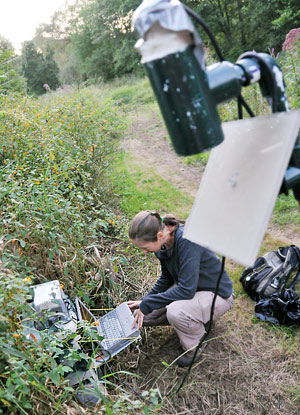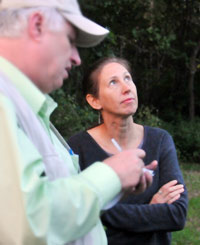Ph.D Candidate’s Bat Research Links 3 Biological Communities

Biology Ph.D candidate Kate Miller treks through a wildflower-lined trail alongside Middletown’s Coginchaug River. She approaches a plastic garbage bin and a PCV pipe protruding from the ground.
“That’s my bat echolocation recorder,” she says. “It’s old but I’m not complaining. It was free and it works.” Miller credits Scott Reynolds, Ph.D, of North East Ecological Services in Concord, N.H. for the loan of the equipment.
Inside the crude setup is a 12-volt battery, an echolocation call recorder and lap-top computer. Every 1.5 seconds, the equipment translates the information into a graph and stores it as a data file on the laptop. Miller opens the lap top and examines the graph, which reveals recorded frequencies vs. time on two axis, in real-time.
The meadow is alive with audible sounds of songbirds, crickets and cicadas.
“Right now we’re picking up something with a 10 to 15 kilohertz frequency. We know that’s not a bat since their calls are usually between 25 and 80 kilohertz,” Miller explains, eyeing the lines on the graph. “Humans can only hear frequencies up to about 20 kilohertz.”
Building on studies that identify stream corridors as prime foraging habitats for bats, Miller hopes to identify which types of stream habitats have the most activity. She also hopes to determine whether or not the composition and abundance of “benthic macroinvertebrates” – mostly aquatic larvae that live on the stream bottom and hatch into flying insects the bats consume – is at all correlated with bat foraging activity. Bats, the only mammals capable of sustained flight, are able to devour more than 1,200 insects an hour.

This is the second summer Miller’s spent recording bat calls at eight different locations in the state. Four sites are on the Coginchaug River, which has a watershed with significant development and agriculture, and four are on the Eightmile River in Salem, Conn., which has a more rural and forested watershed.
To date, she’s collected 64 nights worth of data, consisting of over 10,000 recordings. She recently was joined by field staff of the Connecticut Department of Environmental Protection in an effort to net bats and identify species.
“While no bats ended up in the net, the night was not a waste,” Miller says. “Bat calls were recorded indicating that bats are foraging directly over the river, and the net captured delicate mayflies and crane flies – two insects with aquatic larvae identified in samples taken from the river’s bottom.”
Monitoring bat foraging use is a part of a larger project to assess the impact of habitat characteristics and land use on the biological communities of streams. Her work overlaps that of her advisor, Barry Chernoff, the Robert Schumann Professor of Environmental Studies, professor of biology and director of the Environmental Studies Program.
Between May and October, students in the Chernoff Lab venture into the Coginchaug River and the Eightmile River in Salem, Conn., to identify fish and collect samples of benthic macroinvertebrates. So far, they’ve identified 83 families of invertebrates, such as stoneflies, which can be indicative of high water quality.
“The three biological communities are trophically linked,” Miller explains. “Fish eat benthic macroinvertebrates in their aquatic life stage, and bats eat them in their adult terrestrial life stage. All three communities are dependent, directly or indirectly, on the habitat characteristics of the stream and the landscape.”
Streams contain a wide diversity in habitats and organisms. They also are vulnerable to human activities, since they receive “run-off” from the surrounding land, which may include sediment and chemicals. By understanding those effects on an interacting community of organisms, Chernoff and Miller will be able to examine the components of habitat and landscape that are most critical to preserve a natural diversity of organisms and interactions.
The benthic macroinvertebrate samples are time-consuming to process, requiring careful identification. Between three and six undergraduate, graduate and Hughes and Mellon Fellows work on identification and participate in field work. With their help, Miller should finish her studies within two years.
“Preliminary analysis detects relationships among the three communities, and between them and the landscape.” Miller says, gazing over the river at dusk. “I’m looking forward to teasing out the nature of these relationships and what it means for our understanding, and conservation, of stream ecosystems.”

